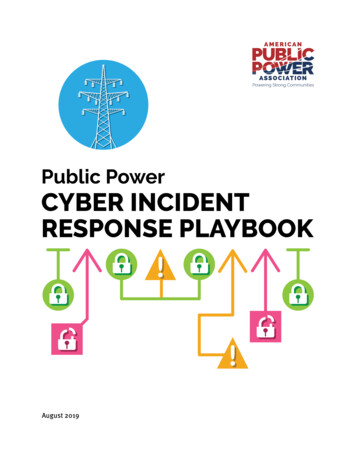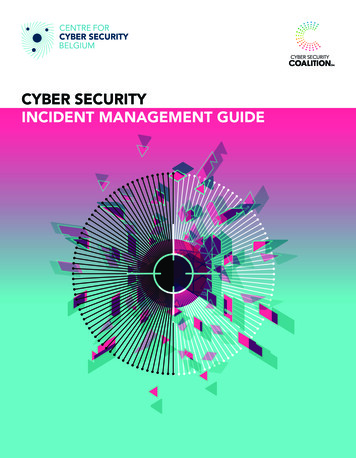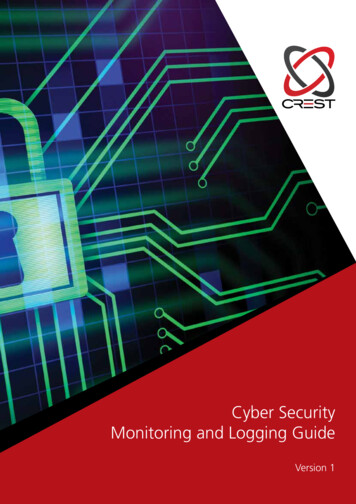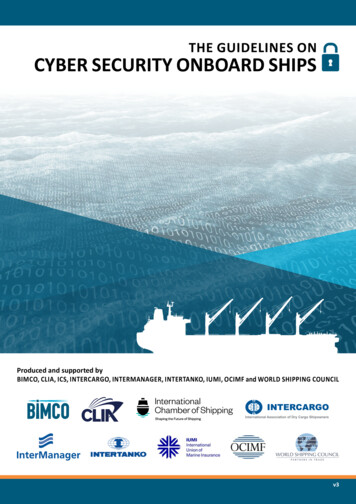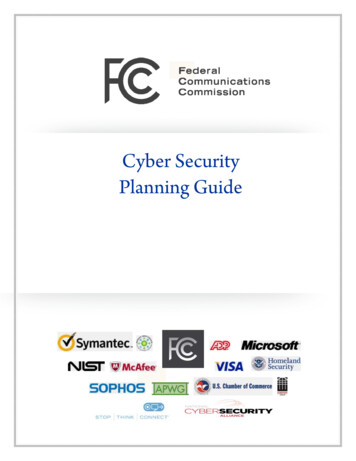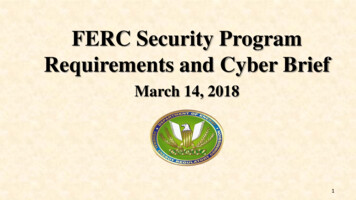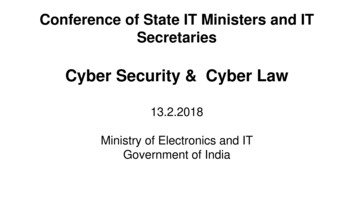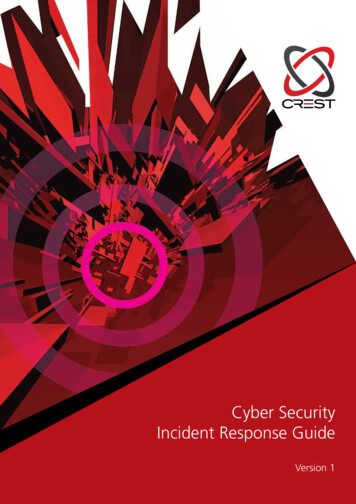
Transcription
Cyber SecurityIncident Response GuideVersion 1
Cyber Security Incident Response GuidePublished by:CRESTTel: 0845 686-5542Email: admin@crest-approved.orgWeb: http://www.crest-approved.org/Principal AuthorJason Creasey,Managing Director, Jerakano LimitedPrincipal reviewerIan Glover, President,CRESTDTP notesFor ease of reference, the following DTP devices have been used throughout the Guide.AcknowledgementsCREST would like to extend its special thanks to those CREST member organisations and third parties whotook part in interviews, participated in the workshop and completed questionnaires.WarningThis Guide has been produced with care and to the best of our ability. However, CREST accepts noresponsibility for any problems or incidents arising from its use.A Good Tip!A Timely WarningAn insightful Project FindingQuotes are presented in a box like this. Copyright 2013. All rights reserved. CREST (GB).2
Cyber Security Incident Response GuideKey findingsThe top ten findings from research conducted aboutresponding to cyber security incidents, undertakenwith a range of different organisations (and thecompanies assisting them in the process), arehighlighted below.1 yber security incidents, particularlyCserious cyber security attacks, such asadvanced persistent threats (APTs), are nowheadline news. They bring serious damageto organisations of all types – and togovernment and international bodies. Waysto respond to these attacks in a fast, effectiveand comprehensive manner are activelybeing developed at the very highest level incorporate organisations, government bodiesand international communities such as theWorld Economic Forum, where cyber securityattacks are seen as a major threat.CYBERSECURITYINCIDENT2T here is no common understanding of what a cyber security incident is, with a wide variety ofinterpretations. With no agreed definition– and many organisations adopting different views in practice– it is very difficult for organisations to plan effectively and understand the type of cyber security incidentresponse capability they require or the level of support they need.3T he original government definition of cyber security incidents as being state-sponsored attacks on criticalnational infrastructure or defence capabilities is still valid. However, industry – fuelled by the media – hasadopted the term wholesale and the term cyber security incident is often used to describe traditionalinformation (or IT) security incidents. This perception is important, but has not been fully explored – andthe term cyber is both engaging and here to stay.45T he main difference between different types of cyber security incident appears to lie in the source ofthe incident (eg a minor criminal compared to a major organised crime syndicate), rather than the typeof incident (eg hacking, malware or social engineering). At one end of the spectrum come basic cybersecurity incidents, such as minor crime, localised disruption and theft. At the other end we can see majororganised crime, widespread disruption, critical damage to national infrastructure and even warfare.Furthermore, the nature of attacks is changing from public displays of capability to targeted attacksdesigned to be covert. rganisations vary considerably in terms of the level of maturity in their cyber security incident responseOcapability, but also in the way in which they need to respond. Whilst good practice exists – and is beingimproved – the lack of both a common understanding and a detailed set of response guidance is limitingorganisational capabilities and approaches, as well as restricting important knowledge sharing activities.3
Cyber Security Incident Response Guide6F ew organisations really understand their ‘state of readiness’ to respond to a cyber security incident,particularly a serious cyber security attack, and are typically not well prepared in terms of:P eople (eg assigning an incident response team or individual; providing sufficient technical skills;enabling decisions to be taken quickly; and gaining access to critical third parties) Process (knowing what to do, how to do it and when to do it), eg identify cyber security incident;investigate situation; take appropriate action (eg contain incident and eradicate cause); and recovercritical systems, data and connectivity Technology (knowing their data and network topology; determining where their Internet touchpoints are; and creating / storing appropriate event logs) Information (eg recording sufficient details about when, where and how the incident occurred;defining their business priorities; and understanding interdependencies between businessprocesses, supporting systems and external suppliers, such as providers of cloud solutions ormanaged security services). 78I n practice it is often very difficult for organisations to identify the type of cyber security incident they arefacing until they have carried out an investigation, particularly as very different types of cyber securityincident can show similar initial symptoms. Even when organisations have comprehensive detectionsoftware and logging it can be difficult to determine the nature of an attack in a timely manner. espite the current level of threat from cyber security incidents, those responsible for preparing for,Dresponding to and following up cyber security incidents in many organisations still face significantchallenges in: Persuading senior management to appreciate the extent of the problem – restricting budgetand resources Knowing who to contact to provide expert help (and why) Involving experts at a sufficiently early stage in proceedings Providing them with sufficient information to be able to investigate effectively.910 ost organisations need professional help in responding to a cyber security incident in a fast, effectiveMmanner. However, it is very difficult for them to identify trusted organisations that have access tocompetent, qualified experts who can respond appropriately whilst protecting sensitive corporate andattack information.E mploying the services of properly qualified third party experts (such as those CREST members whoprovide cyber incident response), can significantly help organisations to handle cyber security incidents ina more effective and appropriate manner – particularly serious cyber security attacks. Research revealedthat the main benefits of using this type of external supplier are in:P roviding resourcing and response expertise, by gaining access to more experienced, dedicatedtechnical staff who understand how to carry out sophisticated cyber security incident investigationsquickly and effectively Conducting technical investigations, by providing deep technical knowledge about the cyber securityincident, including: the different types of attacker (and how they operate); advanced persistentthreats; methods of compromising systems; and sophisticated analysis of malware Performing cyber security analysis, for example by monitoring emerging cyber threats; applyingmodern analytic capabilities to aggregate relevant data from many different systems; and providingsituational awareness, particularly in the area of cyber intelligence. 4
Cyber Security Incident Response GuideContentsPart 1 – Introduction and overview About this Guide. 6 Audience. 7 Purpose and scope. 7 Rationale . 8Part 2 – Understanding cyber security incidents Background. 10 Defining a cyber security incident. 11 Comparing different types of cyber security incident. 12 Typical phases of a cyber security attack. 14Part 3 – Meeting the challenges of responding to cyber security incidents Introduction. 16 The main challenges in cyber security incident response. 16 So how do we respond?. 17 The need for support from the experts. 19 Building an appropriate cyber security response capability. 20Part 4 – Preparing for a cyber security incident Step 1 – Conduct a criticality assessment for your organisation. 21 Step 2 – Carry out a cyber security threat analysis, supported by realistic scenarios and rehearsals . 22 Step 3 – Consider the implications of people, process and technology. 24 Step 4 – Create an appropriate control environment. 30 Step 5 – Review your state of readiness in cyber security response . 31Part 5 – Responding to a cyber security incident Key steps in responding to a cyber security incident. 32 Step 1 – Identify cyber security incident. 32 Step 2 – Define objectives and investigate situation. 35 Step 3 – Take appropriate action. 38 Step 4 – Recover systems, data and connectivity. 41Part 6 – Following up a cyber security incident Overview. 42 Step 1 – Investigate the incident more thoroughly. 43 Step 2 – Report the incident to relevant stakeholders. 43 Step 3 – Carry out a post incident investigation review. 44 Step 4 – Communicate and build on lessons learned. 45 Step 5 – Update key information, controls and processes. 45 Step 6 – Perform trend analysis. 46Part 7 – Choosing a suitable supplier Understand the benefits of using external suppliers. 47 Review Cyber Incident Response (CIR) schemes. 47 Select an appropriate supplier who can meet your requirements. 48 The CREST advantagePart 8 – The way forward Summary of key findings. 50 Cyber security resilience. 51 The need for collaboration. 52 Conclusion. 535
Part 1Introduction and overviewCyber Security Incident Response GuideAbout this GuideThis Guide provides details about how to handle cyber security incidents in an appropriate manner. It provides you withpractical advice on how to prepare for, respond to and follow up an incident in a fast and effective manner – presented inan easy to use format. It is designed to enable you to determine what a cyber security incident means to your organisation,build a suitable cyber security incident response capability and learn about where and how you can get help.US President Obama declared that the“cyber threat is one of the most serious economic and national security challenges we face as anation” and that “America’s economic prosperity in the 21st century will depend on cyber security.”This Guide presents a useful overview of the key concepts you will need to understand to handle cyber securityincidents in an appropriate manner, which includes: a definition of cyber security incidents; a comparison of differenttypes of cyber security attack; anatomy of a cyber security attack; a summary of the main challenges in responding tocyber security incidents; how you can respond; and the need to employ third party experts to help you to respond ina faster, more effective manner.The Guide then provides advice and guidance on how to establish an appropriate cyber security incident responsecapability, enabling you to assess your state of readiness to:1. Prepare for a cyber security incident: performing a criticality assessment; carrying out threat analysis;addressing issues related to people, process, technology and information; and getting the fundamentals in place2. Respond to a cyber security incident: covering identification of a cyber security incident; investigation of thesituation (including triage); taking appropriate action (eg containing the incident and eradicating it’s source); andrecovering from a cyber security incident3. Follow up a cyber security incident: considering your need to investigate the incident more thoroughly; reportthe incident to relevant stakeholders; carry out a post incident review; build on lessons learned; and update keyinformation, controls and processes.PHASE 1PreparePHASE 2RespondPHASE 3Follow UpCYBERSECURITYINCIDENTFigure 1: Key elements in a cyber security incident management capability6
Cyber Security Incident Response GuideFinally, the Guide outlines how you can get help in responding to a cyber security incident, exploring the benefits ofusing cyber security incident response experts from commercial suppliers. It introduces you to a systematic, structuredprocess that you can adopt to help you select an appropriate supplier(s) to meet your requirements.The four key steps in the process for choosing a suitable supplier of cyber securityincident response services (‘The Selection Process’) are described in detail in thecomplementary CREST Cyber Security Incident Response – Supplier Selection GuideThroughout the Guide you will find a set of tips, warnings and quotes provided by a diverse set of contributors,including expert suppliers (such as many CREST members), consumer organisations, government bodies andacademia. These bring real-world, practical experience to the Guide, allowing you to get a better feel for the types ofaction that are most likely to apply to your organisation.AudienceThe CREST Cyber Security Incident Response Guide is aimed at organisations in both the private and public sector.Project research has revealed that the main audience for reading this Guide is the IT or information security managerand cyber security specialists, with others including business continuity experts IT managers and crisis managementexperts. It may also be of interest to business managers, risk managers, procurement specialists and auditors.Purpose and scopeThe purpose of this Guide is to help you to meet a range of different requirements identified by a wide variety oforganisations wanting to know how to best respond to a cyber security incident. The main requirements are laid outin the table below, together with the part(s) of this Guide where more detail can be found.RequirementDetailIdentify the main challenges in responding to a cyber security incident, such as a serious,sustained cyber security attack (be it by state-sponsored agents, organised cybercrime syndicatesor extremist groups)Part 3Learn about the support that is available to help you meet these challenges (both in the publicdomain and from commercial organisations), including advice and guidance, incident managementmethodologies and information sharing servicesParts 3and 7Build a suitable cyber security incident management capability (possibly in support of a wider cybersecurity resilience programme)Part 4Evaluate the level of maturity in cyber security incident response in your organisation, ie your‘state of readiness’Part 4Review the way in which you prepare for, respond to and follow up cyber security incidents, learningfrom proven cyber security incident response processesParts 4-7Determine how cyber security incidents should be identified and handled in your organisationPart 5Select suitable third party experts, be it for some or all of the cyber security response process or justspecialised areas like technical or forensic investigations; situational awarenessPart 77
Cyber Security Incident Response GuideThe scope of this Guide could be very large, so it excludes many elements of some important cyber security topics(but certainly not all), including: The prevention of cyber security attacks, including detailed cyber security threat analytics Cyber security resilience as a whole, including detailed situational awareness Deep technical investigation tools and techniques, typically used by commercial cyber security incident response orforensics experts Cyber security insurance.The material in this Guide will provide valuable input to each of these topics, any of which could be the subject of afuture research project.RationaleCyber is the latest buzzword that has really taken the media by storm. There are examples everywhere about thepossible horrors of cyber security attacks. Many organisations are extremely concerned about potential and actualcyber security attacks, both on their own organisations and in ones similar to them.Cyber security incidents have become not only more numerous and diverse but also more damaging and disruptive,with new types of cyber security attacks emerging frequently.“The UK Government Communications Headquarters (GCHQ) now sees real and credible threats toorganisations through cyber security attacks on an unprecedented scale, diversity and complexity.We’ve seen determined and successful efforts to: Steal intellectual property; Take commercially sensitive data, such as key negotiating positions; Gain unauthorised access to government and defence related information; Disrupt government and industry service; and, exploit information security weaknesses through the targeting of partners, subsidiaries andsupply chains at home and abroad.The magnitude and tempo of these attacks, basic or sophisticated, on UK and global networks posea real threat to the UK’s economic security. The mitigation of these risks and management of thesethreats - in other words, cyber security - is one of the biggest challenges we all face today.”Source: 10 steps to cyber security – jointly produce by the Communications Electronics Security Group (CESG) and the Centrefor the Protection of National Infrastructure (CPNI).Organisations are seldom adequately prepared for a serious cyber security incident. They often suffer from a lackof: budget; resources; technology; or recognition of the type and magnitude of the problem. In addition, they donot have the software, testing, process, technology or people to handle sophisticated cyber security threats, such asAdvanced Persistent Threats (APTs).An effective method of responding to cyber security incidents is therefore necessary for rapidly detecting incidents;minimising loss and destruction; mitigating the weaknesses that were exploited; restoring IT services; and reducingthe risk from future incidents.8
Cyber Security Incident Response GuideCurrent cyber security incident response guidelines can be very useful, but do not typically provide:1. A solid, consistent definition of a cyber security incident - or any real distinction between cyber securityincidents and traditional information (or IT) security incidents2. In-depth guidance about dealing with cyber security incidents, particularly for commercial consumerorganisations outside government or Finance sectors3. Advice on who organisations can ask for help – backed up by selection criteria.Consequently, many organisations do not have access to appropriate external sources and levels of guidance to helpthem prepare for most types of cyber security incident, let alone a serious cyber security attack.The cyber security incident response projectThis Guide is based on the findings of a research project - conducted by Jerakano Limited on behalf of CREST –which looked at the requirements organisations have to help them prepare for, respond to and follow up cybersecurity incidents. One of the main reasons for commissioning a research project was that CREST members wereconcerned about the lack of relevant information many of their customers have access to when responding to cybersecurity incidents.This guide builds on a similar report produced by CREST to help you define realbusiness requirements for penetration testing, to conduct tests more effectively andto choose a suitable supplier of penetration testing services. A summary of CRESTactivities can be found at: http://www.crest-approved.org/.The research project included: Performing desktop research on different sources of information, including GCHQ-related publications, such asthe 10 steps to cyber security from CESG and the First Responder’s Guide – Policy and Principles from CPNI Reviewing a number of other useful guides from international bodies, such as the Good Practice Guidefor Incident Management from the European Network and Information Security Agency (ENISA); the NISTComputer Security Handling Guide (Special Publication 800-61); and Responding to targeted cyberattacks fromISACA (collaborating with E&Y) Conducting telephone interviews with key stakeholders, such as CREST members and clients, academia,CESG and ENISA, with site visits to CPNI, GCHQ and the Bank of England Creating a detailed project questionnaire based on research (and previous experiences), and analysing theresults of responses from participants Discussing key issues and requirements with a wide variety of people at CRESTCon, the CRESTannual conference Running a workshop where experts in cyber security response services from more than 20 organisationsvalidated the findings of this Guide and provided additional specialist material.The CREST project complements the work done by the UK Government (eg CESG and the CPNI) on cybersecurity incident response, but provides more detailed guidance for organisations (particularly in the privatesector), who might need to respond to a cyber security incident in practice - and procure support from experts incommercial suppliers.9
Part 2Understanding cyber security incidentsCyber Security Incident Response GuideBackgroundThe term cyber (which actually means robotic) can be interpreted in many ways. For example, one dictionary definitiondefines the term Cyber as ‘relating to computers and the Internet’, which again can mean different things to differentpeople. Furthermore, project research identified that cyber is often associated with the concept of cyberspace.“Cyberspace is an interactive domain made up of digital networks that is used to store, modifyand communicate information. It includes the internet, but also the other information systems thatsupport our businesses, infrastructure and services.”Source: UK Cyber Security Strategy, 2011Cyberspace is constantly evolving and presenting new opportunities. The desire of businesses to quickly adopt newtechnologies (using the Internet and adopting cloud services to open new channels) provides enormous opportunity,but also brings unforeseen risks and unintended consequences that can have a negative impact.“The interconnectedness of the Internet brings huge benefits to the World but also an unrivalledopportunity for harm”Many computing devices (eg PCs, laptops, tablets and smart phones) are connected to the Internet on an almostcontinuous basis. Technical exploits target not only vulnerabilities in infrastructure, but also in many web-basedapplications. It may be that cyber security is the security of cyberspace and that a cyber security incident is one thatimpacts on cyberspace or uses cyberspace as part of an attack vector.The term Cyber Security is poorly defined – and understood.It often appears to be replacing the term information (or IT) security, rather thanbeing supplementary to it. For example, the PwC / BIS cyber security breaches surveywas previously called the information security breaches survey, but the questionsappear to be virtually the same.The UK Government tendency to focus on Cyber Security and Information Assurance(CSIA) seems to work, but is not well understood by commerce – or commonly usedoutside the UK.10
Cyber Security Incident Response GuideDefining a cyber security incidentThere are many types of information (or IT) security incident that could be classified as a cyber security incident, rangingfrom serious cyber security attacks on critical national infrastructure and major organised cybercrime, through hacktivismand basic malware attacks, to internal misuse of systems and software malfunction.However, project research has revealed that there is no one common definition of a cyber security incident. There is noauthoritative taxonomy to help organisations decide what is (or isn’t) a cyber security incident, breach, or attack.Often cyber security incidents are associated with malicious attacks or Advanced Persistent Threats (APTs), but thereappears to be no clear agreement. Many different organisations have different understandings of what the term means,consequently adopting inconsistent or inappropriate cyber security incident response approaches.The original government definition of cyber security incidents as being state-sponsored attacks on critical nationalinfrastructure or defence capabilities is still valid. However, industry – fuelled by the media – has adopted the termwholesale and the term cyber security incident is often used to describe traditional information (or IT) security incidents.This perception is important, but has not been fully explored – and the term cyber is both engaging and here to stay.The two most common (and somewhat polarised) sets of understanding – as shown in Figure 2 below - are either thatcyber security incidents are no different from traditional information (or IT) security incidents – or that they are solely cybersecurity attacks.Traditional information(or IT) security incidents are: Small-time criminalsCyber security attacks Individuals or groups just‘having fun’ Serious organised crime Localised or communityHacktivists Insiders State-sponsored attackCYBERSECURITYINCIDENTS Extremist groupsFigure 2: Different types of cyber security incidents“We classify all information security incidents as Social; Hacking; Malware; or Misuse; as that is whatis commonly understood”Many respondents to the project questionnaire felt that there is a need to differentiate between a cyber security attack,which requires a more modern approach (both technically and holistically) - and other types of information security incidentthat can still be addressed by traditional incident handling approaches (often forensics or law enforcement led).11
Cyber Security Incident Response GuideComparing different types of cyber security incidentThe main difference between different types of cyber security incident appears to lie in the source of the incident (eg aminor criminal compared to a major organised crime syndicate), rather than the type of incident (eg hacking, malwareor social engineering). Therefore, it may be useful to define cyber security incidents based on the type of attacker, theircapability and intent.At one end of the spectrum come basic cyber security incidents, such as minor crime, localised disruption and theft.At the other end we can see major organised crime, widespread disruption, critical damage to national infrastructure andeven warfare.Some of the most common ways in which different types of cyber security incident can be compared are
academia. These bring real-world, practical experience to the Guide, allowing you to get a better feel for the types of action that are most likely to apply to your organisation. Audience The CREST Cyber Security Incident Response Guide is aime
